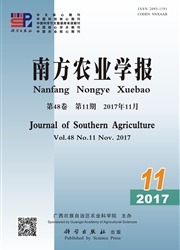

 中文摘要:
中文摘要:
【目的】探讨3种粘虫各龄幼虫对4种寄主植物的取食选择行为,为粘虫的预测预报及防治提供理论依据。【方法】采用叶碟改进法分别测试3种粘虫(东方粘虫、劳氏粘虫和淡脉粘虫)在4种寄主植物(玉米、水稻、甘蔗和稗草)上的取食选择性,分别于接虫后6和24h记录幼虫对各植物的选择数量。【结果】3种粘虫各龄幼虫在接虫后6和24h时对4种寄主植物的取食选择率均有变化。在24h时,东方粘虫各龄幼虫对玉米的选择率均显著高于其他3种寄主植物(P<0.05,下同),其中1龄和2龄幼虫对玉米的选择率分别高达82%和89%;劳氏粘虫1~6龄幼虫偏好取食玉米,其中1龄、2龄和3龄幼虫对玉米的选择率均超过50%,分别为78%、70%和55%,显著高于对其他3种寄主植物的选择率;淡脉粘虫1~6龄幼虫均偏好取食水稻,其中2~4龄幼虫对玉米和水稻的选择率差异不显著(P>0.05)。【结论】3种粘虫各龄幼虫对4种寄主植物的取食选择存在差异,3种粘虫对玉米和水稻的取食选择性强,对甘蔗和稗草的取食选择性较弱;东方粘虫和劳氏粘虫低龄幼虫喜食玉米,淡脉粘虫低龄幼虫嗜食水稻和玉米,高龄幼虫的取食选择性不如低龄幼虫明显。
 英文摘要:
英文摘要:
【Objective】In order to provide scientific basis for prediction and control of armyworms,the present experiment was conducted to investigate feeding preference of Mythimna separata(Walker),Leucania loreyi(Duponchel)and Leucania roseilinea(Walker)larvae at each instar to four species host plants viz.maize,rice,sugarcane and barnyard grass.【Method】In this study,feeding preference of three species armyworm larvae to four species host plants was evaluated by leaf disc method.And the number of larvae selection for each plant was recorded at6and24h after insect inoculation respectively.【Result】The results showed that the feeding preference of larvae at each instar of the three species armyworm varied at6and24h after insect inoculation.All the instar larvae of M.separata preferred maize most at24h observation time,of which the feeding preference rates of1st instar and2nd instar reached as high as82%and89%.And the feeding preference rates of1th-6th instar larvae to maize were significantly higher than those to the other three species host plants(P<0.05,the same as below).Larvae of1st-6th instar of L.loreyi preferred to feed on maize,the feeding preference rates of1st instar,2nd instar and3rd instar larvae to maize exceeded50%(78%,70%and55%respectively)which were also significantly higher than those to the other three species host plants.L.roseilinea1th-6th instar larvae showed feeding preference to rice.While the feeding preference rates of2nd to4th instar larvae to rice and maize had no significant differences with each other(P>0.05).【Conclusion】The results suggest that the larvae at each instar of three species armyworm show different feeding preference to different host plants.All the three species larvae prefer maize and rise most,while the selectivity of them to sugarcane and barnyard grass is weak.Young larvae of M.separata and L.loreyi prefer maize and young larvae of L.roseilinea prefer rice and maize.The feeding preference of older larvae to host plants is not as strong as that of young larvae.
 同期刊论文项目
同期刊论文项目
 同项目期刊论文
同项目期刊论文
 期刊信息
期刊信息
